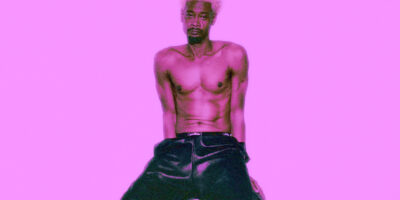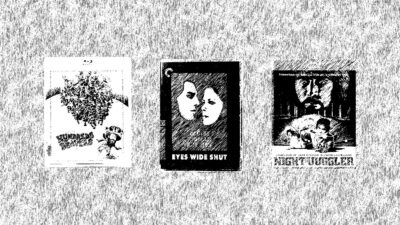When Kreayshawn dropped her debut album 10 years ago, it felt like her rising career had imploded before having a chance to properly begin. Her mega-viral hit song “Gucci Gucci” was barely over a year old, and yet somehow she had already missed her window to capitalize on it, squandering whatever good will she had accumulated and affirming the suspicions of her most vocal skeptics with her debut album, SOMETHIN’ BOUT KREAY’.
In the wake of “Gucci Gucci”—the anti-designer fashion pop rap anthem with a music video that elevated the Oakland artist from obscurity to millions of views in just a few weeks—Kreayshawn signed a deal with Columbia Records. When the major label picked her up, they believed that they could turn the internet rap sensation into a full-blown mainstream pop star. But by the time her debut album was coming out less than a year later, they had already thrown in the towel. A fate worse than the album just getting scrapped altogether, Columbia decided to try to bury this album by sending it to purgatory: making the CD only available to purchase in Hot Topic.
These details—not to mention the album’s title with its double apostrophes, the now painfully dated cover art, the fact that it sold under 4000 copies in its first week, as well as the Hot Topic exclusivity—all quickly became part of the punchline to the joke that was Kreayshawn’s career, with many onlookers seeming to relish in her spectacular failure.
—
Especially in the context of this particular post-Limewire but pre-Spotify music industry of 2012—a no man’s land when charts were not yet factoring views or streams into their sales calculations yet the days of teenagers buying CDs at Hot Topic had already come and gone—it’s honestly kind of impressive that SOMETHIN’ BOUT KREAY’ sold as many copies as it did.
Natassia Gail Zolot, better known by her stage name Kreayshawn, is one of the first people who will point out what bullshit it was that this commercial failure was so commonly mocked among rap music fans and fixated on in the press. Some outlets falsely claimed that SOMETHIN’ BOUT KREAY’ boasted the “lowest first week sales by an artist on a major label.” But that sales statistic immediately became a scarlet letter upon her career, vindication for anyone annoyed by the popularity of “Gucci Gucci” that they were always right to doubt that Kreayshawn was going anywhere.
To an outsider, Kreayshawn’s life looked like a storybook success story up until that moment of the release of SOMETHIN’ BOUT KREAY’. Here was someone who became a viral YouTube star overnight, suddenly being handed a massive record deal with a (much discussed) million dollar advance, flying around the world to perform, and being put on magazine covers. But even before the majority of the public had turned on her, this was far from a fairy tale. In her conversation with Stereogum for the 10th anniversary of “Gucci Gucci,” she clarifies that, “It’s not just as simple as, ‘Oh, poor me. I got famous and I got a record deal.’ It’s, like, I grew up terribly. I have child abuse. I have anxiety, depression, terrible PTSD. I was having seizures all the time. That’s why it sucked.” In that same interview, she describes being completely burnt out by the demanding travel schedule the label was forcing her to participate in—despite not making any money and having to take on many of the day-to-day expenses herself. All the while she was “just constantly drinking lean” and taking opiates as coping mechanisms.
Perhaps the most upsetting event in the series of public and private Ls Kreayshawn endured during her whirlwind rise up and rapid descent down the mountain of viral internet fame was in 2011, when she hosted the VMAs Red Carpet and had her underage nudes leaked online by someone hacking her Twitter account while she was live on TV. As gross as that was in the moment, even worse in hindsight was some of the coverage of the incident. In this article from Vibe, the writer goes out of their way to describe her as a “controversial and not-so-lyrical rapper” and a “bi-curious Cali Girl” before later going on to suggest that she might have leaked the nudes herself for attention.
By the end of the first week of the album’s release in September 2012, the knives were out. Most notably, Pitchfork would publish a 3.0 review of SOMETHIN’ BOUT KREAY’ that was perhaps overly eager to bury her as a one-hit wonder; beginning with the line “Natassia Zolot, the 22-year-old Oakland rapper known as Kreayshawn, rose to popularity in exceedingly modern fashion, but we’ve known how to describe her career since before she was born.” The review’s ice-cold lede concludes “It would be difficult to argue that SOMETHIN’ BOUT KREAY’ is a waste of Kreayshawn’s talent, because talent has been something of a non-factor in her story.”
Ouch.
It seemed as if nearly everyone had given up on the possibility of Kreayshawn’s career achieving liftoff; jettisoning her from culture as suddenly and swiftly as they had bought into the hype. Even California’s favorite rock band the Red Hot Chili Peppers had given up on Kreayshawn, hiring and then swiftly firing her as the director of the music video for their 2011 single “The Adventures of Rain Dance Maggie.” Zolot was a film school dropout, getting her start by shooting videos for other Bay Area rappers, so it makes sense that after the mega success of the “Gucci Gucci” video that she would be tapped to bring that sense of fun to the videos of other artists. However, much as was the case in her music career, she barely got one chance before the plug was pulled on her directing career. In discussing the decision to fire Kreayshawn as director after one day of shooting, Anthony Kiedis said “we had one sort of failed attempt at making a video for this song, which was indoors and just kind of dark and dank and not really fun or anything, so we thought, ‘Let’s go with the opposite of that.’”
Double ouch.
As harshly as that Pitchfork review reads today, and as much as I feel deep sympathy and empathy for what Zolot has been through as both a person and artist, what I am not going to do is try to argue that SOMETHIN’ BOUT KREAY’ is some sort of underrated gem of an album that we should be heralding as a misunderstood cult classic. I have half-jokingly (but mostly sincerely) declared my affection for this album—and the music of Kreayshawn generally— in the past, but taking a serious critical eye to SOMETHIN’ BOUT KREAY’ in 2022 reveals that much of what didn’t work at the time really doesn’t work now. I still have some nostalgia tied up in my fond adolescent memories of blasting album highlights like “Left Ey3” in my Hyundai Sonata, and there are flashes of potential and genuinely forward-thinking ideas at times, but I cannot in good conscience tell you that SOMETHIN’ BOUT KREAY’ is an album without major flaws. Nor does it even rise all the way to something I could call a great or even really good album.
—
Before I go any further into the ballad of Kreay, it is important to place this album into some context. Mostly unmoored from both the decade before and the decade to come, the early 2010s were a particularly strange transitional period for the music industry as a whole, and for rap music in particular. 2012 did boast many notable albums in the genre, including breakthrough albums from artists who would soon become mega-stars like Kendrick Lamar (GOOD KID, M.A.A.D CITY), but besides notable exceptions like Chief Keef (FINALLY RICH) or Death Grips (THE MONEY STORE), there weren’t many records from 2012 that would accurately forecast where the sound of rap music would soon evolve. It’s one of the reasons why the artists and albums from this era that remain interesting are not the biggest names, critical darlings, or marquee event releases. Rather, they are the forgotten curios—the flashes in the pan, the names like Kreayshawn’s that will forever be associated with this brief window of time.
This liminal space, between generations of rappers and between music distribution systems, combined with the growing ubiquity of YouTube and its ability to mint new kinds of stars, made way for some truly bizarre anomalies and viral success stories. There are several artists like Kreayshawn that very easily could have been more successful if they debuted in our current music landscape, but many of these artists could only have existed and had careers at this specific moment in time. Initially, writing this piece was going to be a much more sprawling look into this early 2010s internet rap/“meme rap” scene as a whole, but since the SOMETHIN’ BOUT KREAY’ story has many twists and turns to get to, I’m going to try to keep this to just the most essential characters. (Sorry not sorry, but Diplo and Three Loco, you have been cut for time.)
As previously mentioned, one of Kreayshawn’s initial claims to fame was as a director/videographer, and the viral video that first drew attention to her YouTube account was the music video for Lil B’s breakout hit “Like A Martian.” Commonly credited along with Soulja Boy as being the artist most responsible for revolutionizing how an artist could use the internet as a promotional tool, the shadow of Lil B hangs over discussion of Kreayshawn’s career (as well as that of any other rapper lazily generalized as a “weird Internet rapper”). Lil B and Soulja Boy’s social media presence and music videos became the playbook for how a rapper could turn themselves into a meme, but the crucial difference was that Soulja Boy was a relentless hustler who just happened to find the internet while looking for his angle to stardom, whereas Lil B was genuinely iconoclastic through style and presentation in a way that made him uniquely well-suited to the internet.
Often, the lazy critical response to Lil B is either to dismiss him for his lack of technical proficiency, or to argue that his success as an artist is purely derived from ironic appreciation. This misses the point of Lil B entirely: he is not bad, nor is he “so bad he’s good,” rather he is incredibly good at rapping and fun to listen to in a way that demonstrates no desire to conform to the prescriptive checklist of what was defined “good” at the time. The people who complain about rappers like Lil B not knowing any words besides “swag” fail to understand that the reason Lil B rapped “Like a dad / Like I’m rad / Like I’m Brad / Like I’m Chad” on “Like a Martian” is not because he couldn’t come up with a more clever rhyme scheme, but rather that he knew this seemingly mindless lyricism could be more exciting than any traditional rap punchline if delivered with the right energy. Years later, as rappers like RxKNewphew are rightly heralded for rhyming “King Von” with “King Von” 11 times in a row, it feels almost quaint to recall how much hostility Lil B received for this perceived lack of skill.
This stark originality is on display in the barebones yet undeniably arresting “Like A Martian” video. It’s deceptively amateurish, beginning with a countdown that is not edited out, before jumping right into one of many shaky handheld closeups of Lil B rapping directly into the camera. There are no background dancers, no overarching theme or concept, not even a set that you can clearly make out—just his brightly illuminated face framed by the popped collar of his very 2010 multi-colored flannel shirt and comically large diamond earrings. It seems downright bad at first, but you can’t help but stare at the screen for every second, because the boundless charisma and endlessly quotable lines are all the more surreal and visceral by the Kreayshawn-directed video. Even today, with years of people both imitating the musical style and visual presentation of Lil B, nothing else sounds or feels and looks quite like it—it’s so raw it’s almost claustrophobic, and helped make Lil B an internet sensation.
Kreayshawn’s other most common muses were Lil Debbie and V-Nasty, the other two members of the group unfortunately known as “White Girl Mob.” I went into this piece with the goal of not focusing too much of my time on discourse of cultural appropriation, partly because I think that conversation has become incredibly tiresome and rote as we re-hash the same debates over and over again with every new white rapper, and partly because a white woman’s POV on whether or not the music of White Girl Mob constitutes appropriation is probably unnecessary. But it would be more irresponsible for me to just glide past the issue of race completely, as if it was a complete non-factor in this story. Regardless of how you feel about SOMETHIN’ BOUT KREAY’ and “Gucci Gucci,” it is undeniable that one of the main selling points of this music to some people was the shock value of “isn’t it crazy that a white girl made this?” Not to mention the fact that the “She’s white????” factor certainly had something to do with Columbia’s decision to go all in on Kreayshawn’s career.
There are many parts of the music of White Girl Mob that I can still appreciate, but V-Nasty’s constant use of the N-word is the indefensible elephant in the room. Videos like this one uploaded to Kreayshawn’s YouTube titled “Vnasty freestylin on you barbie hoes” where she uses it are pretty brutal to sit through. Despite the excellent slip-sliding beat to “Let’s Get Faded” and some other songs from the notorious Gucci Mane and V-Nasty collaborative tape BAYTL, it’s impossible to seriously argue for the artistic merit of V-Nasty’s music, nor can you defend Lil Debbie. (I will admit that in the process of researching this piece I have gotten the V-Nasty and Lil Debbie collaboration “Gotta Ball” stuck in my head several times, but anomalies like that very fun song are mostly outnumbered by truly putrid tracks like “Michelle Obama.”)
Lil Debbie does not have the same penchant for dropping racial slurs as V-Nasty, but with Debbie unfortunately also comes her frequent collaborator Riff Raff, as close to a supervillain as this internet rap universe possesses. Without even getting into the two notable public accusations of sexual assault (one of which was settled out of court for an undisclosed sum), Riff Raff represents many of the negatives people associate with this era of internet rap: the blatant cultural appropriation and affected blaccent, his habit for hanging out with barely-18 or underaged girls, the ridiculous and repetitive pop culture punchlines that were almost always some variation on “I’m the white Gucci Mane with a spray tan.” This is a man so purely, deeply skeezy that Harmony Korine made an entire movie about it.
And yet, there are artifacts from this era like the Kitty Pryde and Riff Raff collaboration “Orion’s Belt” that are inexplicably compelling and entertaining—perhaps directly in spite of the talents of the people that made them. The song is especially hard to try to contextualize to anyone who wasn’t there for it, because even in the moment you couldn’t believe it was happening. In hindsight, Kitty Pryde’s bizarrely compelling bubblegum ASMR rap style and Riff Raff’s literal clownery were obvious internet catnip—you can tell before the video starts by the fact that it was premiered by Vice’s Noisey YouTube account. Kitty Pryde rapping lines like “Rap game Taylor Swift / 45 on my hip” certainly shouldn’t be good, but there’s something in the way she delivers it over this beat that overrides my better judgment and critical facilities.
So the question about Kreayshawn really boils down to this: Is SOMETHIN’ BOUT KREAY’ the worst possible version for how her post-“Gucci Gucci” debut could have gone? Or was the success of “Gucci Gucci” a pure freak of nature, stars-aligning coincidence that allowed for her to create an inexplicably entertaining song similar to the way Kitty Pryde and Riff Raff did? Was the fandom of Kreayshawn entirely powered by ironic enjoyment and white teenagers reveling in the idea that they too could perhaps be famous rappers, or was there the makings of something actually special in her music that we never got to see realized?
More to the point: Is Kreayshawn more of an iconoclastic trail blazer like Lil B, or a hacky culture vulture like Riff Raff?
—
If you were to ask Kreayshawn any of these questions directly, I’m not sure she would make much of an argument in defense of her music, as she definitely feels much more negatively about SOMETHIN’ BOUT KREAY’ than anything written here. From the numerous interviews and podcasts she’s done in recent years, it is abundantly clear the album that arrived Saran-wrapped on Hot Topic shelves is far from a final product that she was remotely proud of. This is largely in part due to the aforementioned label meddling, which went beyond releasing her album like a movie studio dumping a movie in early January. SOMETHIN’ BOUT KREAY’ is such a jumbled mess in part because whatever Kreayshawn had in mind for her original vision of the album had been completely cannibalized by the label’s attempts to fit her into their already dated conventions of pop stardom.
Columbia’s first order of business in attempting to break Kreayshawn to the masses was to force her to work with songwriters that could make her sound more pop, ultimately settling on the Danish-born Los Angeles pop songwriter and producer Jonas Jeberg. A relative upstart at the time, Jeberg’s writing credits included attempts at establishing a post-Disney music career for High School musical stars Vanessa Hudgens and Corbin Bleu, as well as the biggest Jordan Sparks single that isn’t “No Air.” Jeberg is credited on every track on SOMETHIN’ BOUT KREAY’, besides “Gucci Gucci,” “Left Ey3,” and the V-Nasty feature “Summertime”—the only tracks Kreayshawn already made before the label began trying to cast her in the role of slightly-edgier-Ke$ha.
Putting aside the fact that these were complete misunderstandings of her appeal, it’s now abundantly clear that Jeberg (currently most known now for co-writing the historically grating song “High Hopes” by Panic! At The Disco) was not the man for the job, and his sickeningly sugary hooks throughout the album are the element that has aged the worst over time. The awkwardness of this forced marriage is most evident on the (obviously tacked on by the label) synthpop album closer “Luv Haus,” which Kreayshawn now describes as “like, the most opposite of me song of all time.” In her interview with Masked Gorilla, she relives the time that her musical hero Pharrell came by the studio while she was working with Kid Cudi (“N.E.R.D. was my shit, that’s like where I discovered what being horny was”), and you can see the embarrassment re-flash across her face as she describes having to sit there as Pharrell listened to the songs that she had already hated when they were recorded.
Even more tragically, the songs that Kreayshawn actually should be proud of, namely “Gucci Gucci,” seem to haunt her just as much if not more than the songs on the album that have become forgotten to time. In a 2020 interview with Paper Magazine, she said that she was “terrified” when a clip of the “Gucci Gucci” video started trending online again, going as far as to say that she said that the song is now “completely traumatizing.” “When that song comes on,” she says, “it makes my ears feel like they’re bleeding.” Part of this distaste for her number one hit is due to the fact that whenever “Gucci Gucci” starts going viral and racking up streams from nostalgic millennial/Gen Z cuspers like myself, she doesn’t see a dime of that money. Until she is able to pay off the rest of that million dollar advance, that song’s success is a millstone around her neck. Instead of being the start of her career, “Gucci Gucci” now represents a reminder of everything that was taken from her.
Perhaps more sinister than the meddling in her music, the bad contract, and the expenses they insisted upon but never told her she would be responsible for (all classics in the major label playbook) were Columbia’s attempts to control Zolot’s physical appearance. On numerous occasions, she has spoken about unnamed people at the label pressuring her to do things like “wear heels” and “take dance classes,” generally treating her like a piece of meat they needed to mold into a recognizable pop star shape. When Kreayshawn finally put her foot down and started refusing these “suggestions,” the label quickly turned hostile on her—she argues that the Hot Topic exclusivity was the “execution style death” she received for her insolence.
—
After the failure of her album and a grueling set of tours across the US and Europe, Zolot had no interest in making more music or cooperating with Columbia, taking a break that quickly became an extended break when she announced publicly that she was pregnant. She admits “in fairness” that getting pregnant wasn’t an accident, doing it not only to “spite them” but also because she knew it would force the label’s hand into letting her free from the endless cycle of tours, photo shoots, and press appearances. Much like the refusal to wear heels, the label did not exactly respond to this gesture with kindness, and as she tells the story in that same podcast, no one from the label congratulated her on this announcement—only making contact a few days later to tell her that she had been dropped from her deal.
Much like the Elaine May movie ISHTAR, which received an irrationally large influx of hatred relative to how many people even saw it because of its widely publicized budget, Kreayshawn was constantly ridiculed not just because her debut album was expensive, but because she was perceived as “wasting” money on something made without “talent.” In one of those cheap shot pieces centered around the low sales numbers, a writer for Acclaim said “Looks like Sony might be regretting that infamous $1 million signing deal. Have you heard about Kreayshawn’s debut album dropping last week? Well, turns out no one else has either.”
You could try to argue that this series of misfortunes is the fault of her own bad business decisions, and that she should have been more wary of signing with Columbia in the first place. But hindsight is always 20/20; the fact that Zolot “had $300 in my bank account and rent was due, and I had no money. I had no job” made that million dollars a truly life-changing sum of money she couldn’t afford to pass up. Yet she was constantly raked over the coals for how much she was offered and accepted, despite the fact that it wasn’t paid to her all at once and she didn’t even receive the sum in its entirety before being dropped.
—
The reason I wanted to revisit the album for this anniversary piece was not simply to make you feel bad for Natassia Zolot, nor was my goal to refute the valid criticisms of her music and mythologize SOMETHIN’ BOUT KREAY’ as some sort of lost masterpiece we were robbed of. But the legacy and impact of this album is much more than just past controversies and millennial nostalgia for a one-hit wonder. If Kreayshawn was merely the gimmick some people saw her as, it seems unlikely that her music would remain as frequently discussed as it is today, unlike artists like V-Nasty and Lil Debbie who are now mostly relics of the past.
“Gucci Gucci” has risen back up to the surface several times as a trending topic on Twitter and TikTok. Despite the fact that Zolot immediately jumps to “Oh, my God, it’s something bad” as a post-traumatic stress response “because that’s how it was back then,” her public opinion rating is more uniformly positive than ever (and, in my personal experience, “Gucci Gucci” continues to absolutely crush any time I do it at karaoke). Notably, internet music critic Anthony Fantano has been one of the loudest proponents of the album’s re-evaluation, taking time in his 2019 video “10 Times I Changed My Mind On Albums Part 2” to not only mildly defend the album as “dumb silly fun,” but to go as far as to say the album’s best tracks are “cutting edge and even predictive of the current state of pop rap.”
It is unquestionable to me that Kreayshawn could have made a better album, and she even has refuted fans who defend SOMETHIN’ BOUT KREAY’ to her, saying that ”it was rushed and I was high as shit every day.” But music is a subjective artform all about emotions and experiences, and despite the number of things “wrong” with this album, many of the songs are fun despite their inherent corniness. Making music that is as simple and entertaining as the very best Kreayshawn songs is much harder to do than she makes it look, in the same way that a souffle is light and airy but difficult to make correctly.
That effortless lightness is best exemplified by “Bumpin’ Bumpin,” Kreayshawn’s underrated pre-fame hit that was later re-sampled into the beat of “Gucci Gucci” itself. If Kreayshawn was taken a little more seriously, the way she glides and bounces over the electronic beats and croons in Auto-Tune on this song would be well remembered as a groundbreaking moment that set the template for future artists like Playboi Carti, who approach rapping and singing primarily through melodic and rhythmic feel rather than proper lyricism. More importantly, the FLINSTONES hoodie she wears in the music video is so sick and I think about it constantly.
Kreayshawn makes music that is, first and foremost, about having a good time, so it’s no wonder the corporatized indie sleaze pop album they forced her to make during a traumatic period of her life wasn’t as fun as those early hits. Her music was clearly more exciting and alive when there was no one breathing down her neck trying to get her to change her appearance and record awful demos, and the music she has made in recent years is evidence of that fact. Now that Zolot is in a much happier place in her life, her music as Kreayshawn has returned to its best qualities of seemingly effortless simplicity. In 2021, on an EP called WORLD’S BIGGEST IDIOT, she released the song “Beat My Ass,” in which she raps about getting “curb stomped” and “close-lined” with the same bravado of rapping about not needing designer brands to get a fit off. The song succeeds at being hysterically funny without veering into the cloying “Judd Apatow please think im funny” “comedy rap” of artists Lil Dicky, something that is also harder to do than she makes it look.
We don’t have to wonder hypothetically whether Kreayshawn would have recorded a big TikTok hit if she debuted now, because her 2019 song “Missing Kitty” (about, you guessed it, a cat that goes missing) has become a popular TikTok sound and amassed almost 10 million Spotify streams. Even though the track has an obvious sadness at the heart of it, “Missing Kitty” has that same light-on-its-feet quality of tracks like “Bumpin Bumpin” that allows you to slip into having a fun time without even realizing it. Similarly, “Gucci Gucci” wasn’t written by Kreayshawn (in the days where being accused of having ghostwriters was a cardinal sin instead of a rap industry standard), but the song would be nothing without the charisma and exuberance she brought to that performance. It’s what made the music video so fun: watching her mob down Melrose—home of those designer fashion stores like Fendi and Prada—with a crew that included members of Odd Future like Jasper and Left Brain and, of course, Lil Debbie in one of the most 2011 fashion looks of all time.
In the “Gucci Gucci” music video, you can tell everyone, especially Kreayshawn herself, are having a fun time making it. You can’t help but want to join in. And while I would love to see Kreayshawn’s comeback, just to catch a sense of that joy again, one of the clear lessons of this story is that forcing her back into the industry and limelight that nearly killed her is the last thing she needs. Both her music, and her life, are better off and more fun without it.














Comments